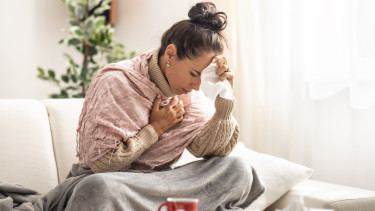Respiratory season milder in Hungary than in the last two years, Covid still rules

On the 47th week of 2024 (18-24 November), 200,800 people sought medical help with acute respiratory infections, including 20,000 people with flu-like symptoms, according to data released by the National Centre for Public Health and Pharmacy (NNGYK) on Thursday. The above figures mark a cc. 12% increase over the respective data of the 46th week.
Note that both the 43rd and 44th weeks had only four working days due to national holidays, hence the fewer number of cases in the statistics.
A short-term comparison (for the last three seasons of respiratory illnesses) shows that the number of patients with ARI was higher than in the previous two respiratory seasons, while the number of people seeking medical help with flu-like symptoms was slightly higher a year ago, but lower two years ago.

The share of flu-like symptoms in ARI was unchanged at 10%, and was only a tad lower than a year earlier (10.2%), while exceeding the 2022/23 figure (7.6%).

We also have data for ARIs and flu-like symptoms per 100,000 population, although a long-term data series is available only for the latter.
in terms of ari, the situation is better than in the previous two respiratory seasons, while in terms of flu-like symptoms per 100,000 population was worse only once, in 2023/24.


A total of 259 samples were tested on the 46th week (down from 266 a week earlier), of which 29 came back COVID-19 positive (down from 33), i.e. they detected coronavirus in 11.2% of the samples, which compares with 32.1% a year ago when 302 samples were tested, of which 97 showed the presence of SARS-CoV-2.


As the chart below attests, SARS-CoV-2 continues to be the main pathogen in samples, with 364 positive tests (almost one fifth of the 1,950 samples tested), followed by rhinovirus (27), influenza (9), RSV (5) and parainfluenza (4).

128 people with severe acute respiratory infection (SARI) were hospitalised on the 47th week, of whom 10 (or 7.8%) required intensive care. The respective figures for the 47th week of 2023 were 223 people in hospital, and 20 (9.0%) in ICUs.

Further breakdown shows that 22 people (17.2% of SARI patients) were hospitalised with coronavirus infection, down from 24 a week earlier and well below 149 (66.8%) a year earlier.

Of the 128 people in hospital with SARI, 26 (20.3%) were aged two or younger, while 35 (27.3%) were 60 and above.

Also, 17 (77.3%) of the 22 COVID-19 patients were over 60 years of age.
A year ago, of the 223 people in hospital with SARI, 39 (17.5%) were aged two or younger, while 139 (62.3%) were 60 or older. Also, 115 (77.2%) of the 149 COVID-19 patients were over 60 years of age.

The age breakdown of people seeking medical help with ARI and flu-like symptoms are shown below.
The majority of ARI patients belonged in the 0-14 age group throughout the 'flu season' last year, while the share of people going to the doctor with flu-like symptoms was the highest in the 15-34 age group up to the 2nd week of this year when the youngest were in majority until the 40th week bar a couple of weeks towards the end. You fund a heat map in our previous article here.


Suspected pertussis cases pick up
We have whooping cough statistics only up to the 46th week but these show that the pertussis season is winding down, although the number of suspected cases did rise further to 38 from 37 on the 45th week. The microbiological tests performed confirmed the clinical diagnosis in four cases. Diagnostic tests are still ongoing in the remaining patients.

The total number of cases rose to 1,165, which is a record. Well, look at this chart.

This is how the epidemic went down, (er, up) this year:

Portfolio has previously reported in several articles that the most vulnerable group is infants. They were also the group with the highest incidence on the 46th week. In the first 46 weeks of this year, 257 of all suspected cases, almost one in four, were infants, but the prevalence in the 40-49 age group is also rather high. If we look at a wider age group of children between 0 and 14 years of age, they make up 42.8% of all cases this year (499 in total), while up to 19 years the share is 51.9% (605 cases).

Cover image (for illustration purposes only): Getty Images










